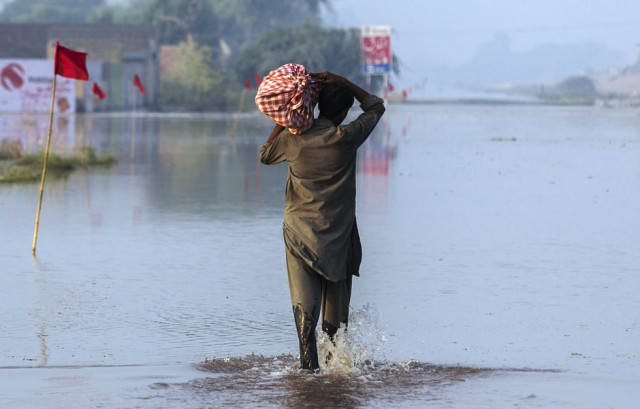Damage assessment: Floods trigger fears of food insecurity
Over Rs10b required to resume agriculture in flood-hit districts: report

Damage assessment: Floods trigger fears of food insecurity
This year’s monsoon-induced floods have triggered fears of food insecurity and threatened livelihoods of peasants in the areas swamped by floodwater, according to an assessment report.
The multi-sector rapid need assessment report highlights that at least 250,000 farmers have been badly affected and at least Rs10 billion is required to help them resume agricultural activities in the affected areas. The flooding destroyed standing crops, killed livestock and curtailed livelihood activities – and this would have a devastating impact on food security.
The report – Recovery Needs Assessment and Action Framework 2014-16 (RNA) – was jointly prepared by the National Disaster Management Authority and UNDP, with input from FAO, ILO, UN-Habitat and WFP.
The report recommends helping farmers with special focus on the cultivation of Rabi crops that will be sown in winter and harvested in spring. Over a million acres of farmlands were swamped and an estimated Rs10,914 million would be required for initial recovery of agricultural activities, it says.

At present, the biggest challenge, according to the report, is restoring lives and livelihoods ideally to a level where they become more resilient to future disasters, while structural and non-structural disaster risk reduction measures are inculcated at all steps of the recovery process.
The report highlights that sound planning, sufficient resources and time will be required for complete recovery of livelihoods and food security.
Agriculture is one of the worst affected sectors. At the time of the flooding, cotton, rice and sugarcane crops were ready to harvest. Extensive damages were reported in Jhang, Muzzafargarh, Multan and Sargodha districts where agriculture is the main source of income for over 55% households and of them over 70% reported loss of livelihoods.
Satellite imaging
Satellite imaging by the Space and Upper Atmosphere Research Commission (SUPARCO) was also used to assess the flood damages. Based on the area of crops inundated by the floodwater and per acre yield averages, SUPARCO forecasts a 217,000 ton reduction in rice production, 726,000 in sugarcane and 250,000 bales of cotton.
Along with this, loss of seed stocks and agricultural tools, destruction of irrigation channels and land erosion further deteriorated the agriculture sector.
Livestock
Livestock rearing is often considered a secondary source of income and also fulfils household food and nutrition needs. Overall 1,925 small and large ruminants were reported to be lost due to floods, with higher losses in Neelum, Bhimber Haveli and Kotli districts of Azad Jammu and Kashmir and Sialkot, Gujranwala, Hafizabad and Gujrat districts of Punjab.
According to RNA estimates, Rs233.47 million will be needed for the recovery of livestock sector.
Household food security
Household food security was also affected, mainly due to the loss of food stocks. Findings indicate that 37% of households lost most of their food stocks. Livelihood losses further reduced their economic access to food and 62% of households reported that they did not have sufficient resources to buy food after the floods. Other impacts, including losses in the fishery and forestry sectors, were also reported in the assessment.
According to the report, low income households are often more vulnerable in disasters.
Findings revealed that Multan, Muzzafargarh and Bahawalpur have highest proportion of vulnerable people. The proportions of BISP beneficiaries, as well as small land holders, are higher in these districts. Following these districts, Jhang, Jhelum and Narowal have higher numbers of vulnerable households.
Published in The Express Tribune, November 16th, 2014.



















COMMENTS
Comments are moderated and generally will be posted if they are on-topic and not abusive.
For more information, please see our Comments FAQ